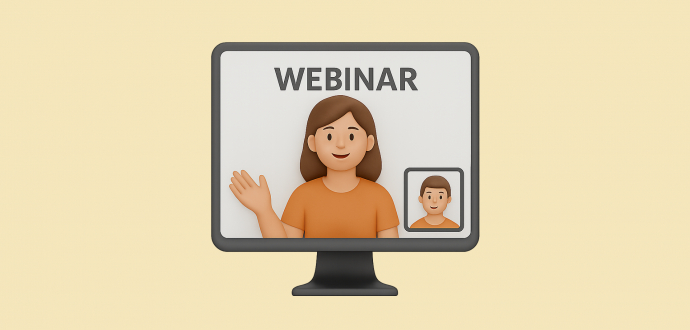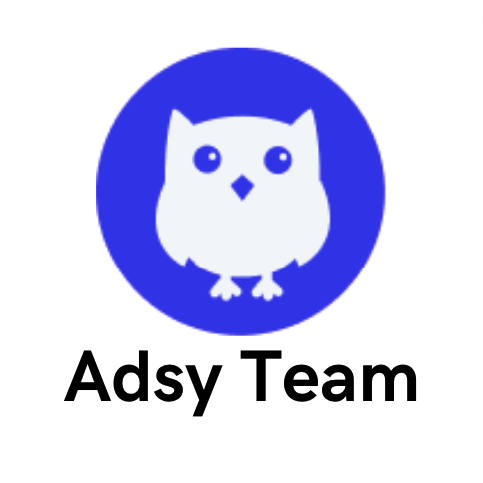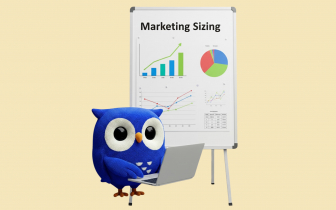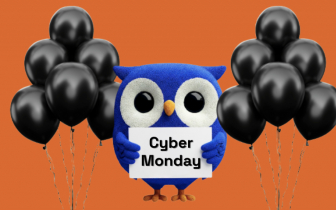Webinar Planning Template for Stress-Free Prep

A webinar strategy template is more than just a checklist with a program for an online event. It is your best friend to create a meetup with less stress and mess around.
When you have a clear structure, you know exactly what to do at every point in time. But this is only possible when your framework is detailed enough. That’s exactly why in this guide, we’ll:
- Walk you through all the steps you need to take to create your own template.
- Give you a free framework that covers everything you need for a successful webinar.
- And share our best tips to make the whole process smoother.
Can one framework work for different events?
The short answer? Yes. It is very possible to have a single template that is designed to go well with different scenarios.
But for this to work, you have to choose a template with the following features:
- Highly customizable: You should have the option of tweaking (adding, removing, etc.) anything easily.
- Scalable: Ideally, you should be able to apply your framework to an event of any size, whether you have one speaker and five attendees or 20 speakers and thousands of people in the audience.
- Clear and easy to understand: The structure should be very logical for you to navigate – otherwise, it’s way too easy to get lost.
- Collaborative format: The only way to properly prepare for a webinar is to work with several people across teams. So, if your template is in the PDF format, it might not be the best solution.
When built this way, you can easily adjust any pre-made structure and tweak it for your specific needs. That’s why you can use the same framework for many different virtual events and conferences.
But there is always a “but.”
The thing is that what defines your event is content. So, even if the framework is the same for multiple webinars, the content and specific details in each will look very different based on what you’re preparing for.
If that sounds confusing, then think of the template as the foundation for a house.
Even if the foundation is the same for two houses, the finished building can be very distinct. Because the owners will have different tastes (and needs) when it comes to the details like colors, building materials, etc.
All in all, a good framework is a universal structure that helps you save time. Just drop your content, tweak it here and there, and you’ll be good to go.
Use our Notion template
In a bit, we’ll walk you through the essential steps to take when building your own framework. But frankly, many of you know that planning a webinar is so much work already. So, if you don’t want to add the stress of crafting a webinar template from scratch, just use ours.
You can tweak it to suit your own needs while collaborating with your team, tracking tasks, sharing feedback, and much more.
It comes in Notion, but you can copy-paste it to any other platform or format, including Google Docs, Excel, or even PDF. Though if you plan to use this with the rest of your team, we really recommend that you avoid static forms like PDF.
These are only a few things you get in our webinar planning template:
- Clear structure to list your speakers and all the prep materials you need for them.
- A way to track your attendees and analyze the most successful acquisition channels.
- Content management framework to prep everything for your online event.
- Tech setup and checklists to make sure that everything works the way it should.
- Ways to monitor and schedule your promotional and follow-up strategies.
What should it cover for successful planning?
Quality webinars are one practical way to get customers without selling. After all, the idea is to share insights that attract people and make them want more.
Still, it is easy to fall into the trap of creating a webinar strategy that seems to cover everything but actually says nothing. This is why some brands struggle to get real audience engagement during their events.
If you want to avoid that hassle, then you want a framework that includes the following:
1. Topics and audience
If you want your attendees to find your online meetup actually useful, you have to understand them and their needs first. So, of course, it all starts with good webinar planning.
Before you do anything, define your target audience and the topic you want to explore. If you get these basics right, you will be on the right track for nailing everything else.
So, where do you start?
Have a clear goal (or a couple of them)
Decide early on whether you want to generate leads, launch your latest product, or present your research. Maybe even all of those?
The thing is that webinars are highly versatile, so almost any goal could work. But the important part is that you have to understand it before you start preparing your event. Once your target is clear, you will know what direction to go with your topics, speakers, and anything, really.
Just don’t overdo it here. While you can have several objectives for one session, you want to have a clear CTA for your audience. Otherwise, it’ll be hard to even measure the success of your meetup.
Understand your attendees
Here, often, businesses have two approaches to their audience:
- Their typical clients and prospects as their potential attendees for any webinar (and any marketing activity).
- Well-segmented mailing list for different topics, funnel stages, etc.
Whether you are taking a more generic or more particular approach, you want to understand who you are creating your event for. It can be a short description or a whole ICP for every (or all) events.
You can even specify exactly who your online event is for if you don’t want to have random attendees.
Source: Score
Go with one specific topic
While you can’t have several goals, you don’t want to go with a topic that’s all over the place. If your subject is too broad, many people (especially in B2B) will think it’s going to cover only basic details, which, to be fair, is what usually happens with generic topics.
On the flip side, a topic that is very specific and focuses on real-life challenges will catch attention. It’s more likely to deliver more targeted value and help you establish your expertise in that area.
Following this principle, going with a title like “Everything to know about SEO” isn’t the best idea. Instead, you would want to focus on a specific part of SEO. So, something like "Guest posting that works: Find pages and get accepted” is more likely to draw interest.
You can then create subtopics to address specific challenges or points based on that. This way, your topic will have a logical flow from one point to another and provide more depth.
Here is a good example of how you can split your main subject into subtopics:
Source: Search Engine Journal
Of course, for that to work, you will need to understand the specific pain points of your audience that your meetup actually addresses. And a great bonus is that the attendees who come for a particular topic are much more likely to convert if your product/service solves their issue.
Package your idea properly
Without proper packaging, even the best webinar might not attract as many people as you want. So, it’s important to consider the following:
- Your topic and headlines should have a clear hook that grabs attention.
- There should also be a promise that lets people know what they gain by attending.
- And if possible, how quickly they can see the results.
Now, let’s see how this works in real life:
Source: Search Engine Journal
Here, SEJ clearly presents a problem (doubt) many businesses have these days – how will their SEO work in the “AI mode”?
Their topic is a perfect example of how you could be specific enough to attract more people, but generic enough to draw a mostly relevant audience.
2. Content and format
Congratulations on getting the hardest element out of the way. Now comes the fun part. This is where your webinar marketing plan template begins to really come alive.
First, you want to make sure the structure of your framework is flexible enough to meet your needs.
Ideally, you should indicate what kind of content you will need based on the audience, the resources you have, and the people responsible for this.
This is also a section where you decide whether you need a presentation and what slides it should include. Do you want to use videos, interactive visuals, or maybe you need different charts and graphs?
Still, no matter the content format, most webinars usually follow a formula that starts with:
- An opening that grabs attention.
- The actual content – made up of educational material, visuals, and interactive elements.
- The wrap-up with a clear call to action.
So, chances are high that your content will also follow the exact same “recipe.”
But honestly, you can play around with the structure as much as you want. There is no right or wrong here. Make your online event as fun as you wish.
Often, even your landing page copy will already set the mood, like in this Semrush meetup:
Source: Semrush
After all, you want to make sure that your content does not sound like a monologue or a boring lecture. How?
Interact with your audience, show real-life cases, and answer their questions. Include useful insights and actionable suggestions that your listeners can apply to their own challenges.
Also, keep the information bite-sized when in doubt. Your webinar should feel like a highlights reel, not a never-ending lecture. In fact, many experts recommend that you keep your focus on just 3 to 5 key points for maximum impact.
A proper template will help you structure and prep all that:
We strongly recommend that you include visual and interactive elements. You want to avoid anything that makes it feel like you're giving a one-way class. So, add some polls, a Q&A section, or even more “informal” breaks.
Besides, pay special attention to slide design, graphics, and video clips that can help keep your presentation engaging. Just don't make them look too cluttered, or use weird design choices.
And, of course, don't read from your slides – they're not meant to replace you.
3. Speakers
The right speakers can make your webinar, and the wrong ones can…well, you get the picture. While you can host your webinar alone, often, getting some additional expertise is a good way to add value to your meetup.
Source: Semrush
So, your webinar template should have clearly defined guidelines for not only choosing the right speakers but also prepping and supporting them before the event. If it doesn’t do this, then you might want to look for some alternatives (unless you have no speakers, of course).
Your experts could be responsible for presenting your content, but more often than not, they prepare their insights by themselves. Still, you might need to design some slides (if needed), and your template has to include this opportunity.
If it’s a panel discussion, and your speakers have to bring different perspectives on a shared topic, you might need to create several presentations. Alternatively, you might ask your guests to prepare their supportive materials.
Often, you will also need a host apart from the main speaker to manage the chats, make sure the tech works, and moderate Q&A sessions.
Ideally, the framework you use should outline all the roles and responsibilities clearly to avoid any confusion.
When you have several speakers at the same meetup, your webinar schedule template should clearly say who handles what topic and when. Because it’s easy to get lost and turn the whole webinar into a mess when you have many experts involved.
4. Timeline
When drawing up a webinar marketing plan, you will need to coordinate various tasks at different stages.
So, apart from having great project management skills, you want your framework to include a clear timeline where every team member can see what’s going on. As much as possible, you want to identify key milestones that may affect other tasks.
If you start early, you have enough time to pick the right speakers, promote the event to build awareness, take care of the technical side of things, etc.
So, if possible, try to extend your deadlines slightly, especially for the critical tasks – just in case. That extra bit of time can save you from stressing out too much when unexpected issues pop up (and they most likely will, as always).
Here’s how you can divide your timeline:
Prep phase
This is when you lay the groundwork for your webinar, making sure that everything is in place to make the event a success.
For many people, this could be as early as eight weeks before. For some big companies and complex conferences, it could even be several months before the actual meetup. But as you understand, it will be different for every case.
This is the time to decide:
- Dates,
- Objectives,
- What platforms to use,
- Who does what,
- And other essentials.
Pay attention to the due date for each task and if there are any dependencies that overlap with other activities.
There is so much going on at this stage with building the landing page, crafting content, deciding on the technical stack, and so on. So, you want to be able to track the status of each task to avoid potential issues that could lead to major problems.
During the webinar phase
This is the part where you focus on making sure that the live delivery and real-time engagement with your audience are off the charts.
You want to make sure that your speakers are already in at least 15 minutes before the start. Besides, everyone (including the attendees and presenters) should be aware of the flow of the event.
Technical checks should have been carried out by now, and you are ready to start your virtual session. One more thing, make sure to record your meetup. This recording will come in useful for your post-webinar phase. More on this later.
Pro tip: Your online sessions should not be too long. If needed, you can schedule 5-minute breaks. Yet, this will depend on the style of your event.
Post-event phase
This is the part where you use the insight gathered during the webinar to plan your next move. What you do at this stage will typically make or break your relationship with the attendees going forward.
Often, this comes down to proper follow-ups, sending recordings to your audience, placing the contact in the right mailing list, collecting reviews to promote future events, etc. We’ll look at all these in detail in the last section on this list.
5. Promotional strategies
The earlier you get in on this, the better. The promotion for your webinar must start no later than two weeks before the event.
When it comes to your webinar planning template, it must include an easy-to-follow structure to help you effectively build awareness and track registration.
Your promotion plan will often start with building a registration page, which is great for raising awareness and getting people to sign up.
Source: Google
For this landing page to be effective, you need to have:
- Clear details about the event – what will people learn?
- Easy registration process – no one wants to fill in dozens of fields just to sign up.
- Speaker bios (or at least short creds) and headshots.
- Event agenda.
Source: Google
Of course, you want to use multiple channels for your promotional activities, including email, social media, ads, etc.
Email promotion is usually one of the most popular and effective channels for marketing webinars. That is, if you have the right audience on your mailing list and the right message strategy.
So, you want to build well-segmented email lists based on people’s interests and engagement levels. For example, you can segment your audience into current clients vs. cold leads. This will come in handy for knowing how to craft your messages to persuade them to register.
Still, emails alone are not enough, so you need to expand your promotion activities to include social media:
- If you're a B2B company, then platforms like LinkedIn would work well for you.
- If you're a B2C, then you might consider Instagram, Facebook, and TikTok to try to increase your sign-ups.
You can post teaser videos on those social media platforms to help amplify your reach.
Depending on your niche and your budget, you might even decide to use ads or partner up with influencers and relevant brands to create more interest. If you’re new to this, you can learn from brands that have mastered creative marketing campaigns for promoting their products.
Depending on the level of your online event, you might want to do some PR as well.
In this case, make sure you first find something special about your webinar, then write a clear and easy copy, and send it to different media to get your press releases published.
6. Tech setup
It's really going to be difficult to pull off a successful webinar if you're having issues with the tech setup. No one wants to watch a buffering screen or have frequent glitches while they are attending a virtual event.
So, the first thing you want to do is choose a reliable platform like Zoom, Google Meet, or something else. The good thing is that there are tons of choices out there, so you’ll definitely find something that integrates with the tools you already use and falls within your budget.
Naturally, you're going to want to make sure the platform is updated, has the capacity to accommodate all your attendees, and has interactive features.
Next, you want to invest in the right equipment. This includes a high-quality camera, a microphone, lighting, etc.
Source: Cheqroom
The slide-sharing and screen-sharing features can function differently depending on the platform you're using. So, you want to check this beforehand to catch any compatibility issues or formatting problems.
Recall how we said you need to record the webinar for post-webinar uses? Well, you might want to test that your chosen platform allows you to record for as long as you need to.
Your framework can be a lifesaver here. So, look for options that can help you:
- Clearly see the setup and who’s responsible for what.
- Has a checklist that allows you to track your stack.
- Offers you a structure for a backup plan.
7. Follow-ups
Most webinar strategy plans have a similar guideline for the post-event steps. You want to see that you make the most of your concluded session.
First, reach out to your attendees with a thank-you email. This shows that you value their time. It is also a perfect opportunity to include a link to the recording so they can watch it again if they need to.
Besides, you can also follow up with people who registered but still failed to attend. So, make sure you create different email sequences for each type.
And guess what? That recording you made also comes in handy for content distribution purposes. This is why most templates include the process for editing the content and repurposing it for short video clips, SM posts, podcast episodes, or even blog posts.
This way, you will be able to get the most value from your online meetup beyond just the actual event.
Bonus tips for stress-free webinar hosting
Now, you know how to create an actually useful template and have several strategies to make your online events smoother and more successful.
But here are some bonus tips to help you bring your webinar planning even further:
- Rehearse at least once. There is nothing worse than spending weeks on preparation and then getting all kinds of issues, from technical problems to awkward speaker coordination. So, if you can, at least check your connection, sound, recording, and files.
- Prepare backup tech (slide deck, Wi-Fi hotspot). Sure, technology is getting better and better, possibly every day, but it can still fail. So, make sure you have a backup strategy if your slides, Wi-Fi, or any other equipment stop working.
- Pre-write scripts and talking points. While you don’t need to write every single thing you want to say, it’s very helpful to have clear points listed for everyone to see. This helps your speakers avoid any awkward moments and keep your event structured.
- Have a co-host or moderator. A webinar has a lot of moving parts, so if you can, try to add moderators to help keep everything running smoothly and let speakers focus on delivering value.
Conclusion
It takes a lot of effort, sweat, and careful planning to put together an effective webinar strategy template. But we know that with what you have learned so far, the process should be much easier for you.
Feel free to start with our Notion framework and then take out or add whatever sections you need. This will save you tons of time, and you can channel your attention to actually planning the best online event.







